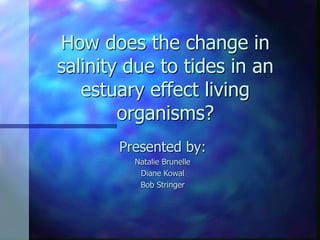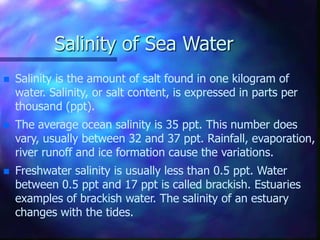Salinidad en estuarios
- 1. How does the change in salinity due to tides in an estuary effect living organisms? Presented by: Natalie Brunelle Diane Kowal Bob Stringer
- 2. What is an Estuary? ïŪ Native Americans once called the estuary "Between-Land", not quite land and not quite water. ïŪ Today, an estuary is defined as a water passage where the tide meets a river current.
- 3. Salinity of Sea Water ïŪ Salinity is the amount of salt found in one kilogram of water. Salinity, or salt content, is expressed in parts per thousand (ppt). ïŪ The average ocean salinity is 35 ppt. This number does vary, usually between 32 and 37 ppt. Rainfall, evaporation, river runoff and ice formation cause the variations. ïŪ Freshwater salinity is usually less than 0.5 ppt. Water between 0.5 ppt and 17 ppt is called brackish. Estuaries examples of brackish water. The salinity of an estuary changes with the tides.
- 4. The Effect of Tides on an Estuary In a typical estuary, there is a constant change in the salinity of the water. As the tide rises, water from the ocean begins to surge into the mouth of a river, bringing with it higher levels of salt. This results in an increase in the salinity of the water in an estuary. Several hours later, at low tide, the ocean water recedes resulting in water with a lower salinity.
- 5. HIGH LOW DATE AM hgt PM hgt AM hgt PM hgt 1 Tue 3:34 2.6 4:01 3.2 8:50 0.5 9:56 0.5 2 Wed 4:33 2.9 4:58 3.5 10:06 0.3 11:00 0.2 3 Thu 5:27 3.3 5:51 3.7 11:16 0.1 11:55 -0.1 4 Fri 6:17 3.7 6:41 3.9 - - 12:16 -0.3 5 Sat 7:06 4.1 7:30 4.1 12:44 -0.4 1:10 -0.5 6 Sun 7:54 4.3 8:18 4.1 1:30 -0.6 2:02 -0.7 7 Mon 8:42 4.5 9:06 4.0 2:16 -0.7 2:52 -0.7 S A K O N N E T 41o28'N 071o12'W Rhode Island Tide Chart - Oct. 2002
- 6. Changing Salinity in the Westport River Estuary Salinty of Westport River During One Tide Cycle - 9/21/02 0.0 5.0 10.0 15.0 20.0 25.0 30.0 M HW 2 hours afterM HW 4 hours afterM HW M LW 2 hours afterM LW 4 hours afterM LW Tide Level Salinity(ppt) Series1 Series2
- 7. What Lives in an Estuary? ïŪ Birds ïŪ Fish ïŪ Insects ïŪ Mammals ïŪ Plants and ...
- 8. Orange Striped Jellyfish Scallop Stalked Jellyfish Opalescent Nudibranch Hooded Nudibranch Brooding Sea Anemone Skeleton Shrimp Sunflower Star Blood Star Bubble Shell Dungeness Crab Hermit Crab Native Littleneck Clam Bent-nosed Clam Mud Shrimp Purple Shore Crab Lugworm Sea Creatures
- 9. How do the changing tides effect life in an estuary? One example of an organism that has adapted to life in an estuary is the cord grass, Spartina. Spartina can survive in salt water where many plants would die. This is a result of an adaptation. Spartina has little openings that allow it to drain out the salt so it can survive.
- 10. Science is difficult to study in isolation. A study of ocean chemistry naturally raises questions about its relationship with living organisms. What kinds of questions does this presentation raise for you? There is lots of information on the web to pique your curiosity. Take some time to surf the net.










